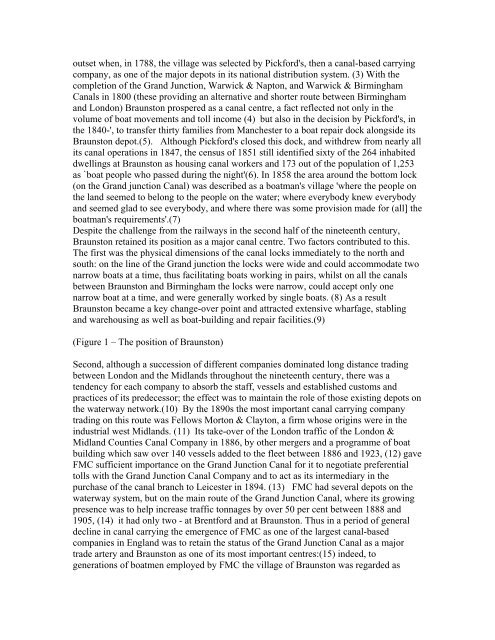The canal boatmen's strike of 1923 - The History of The Narrow Boat ...
The canal boatmen's strike of 1923 - The History of The Narrow Boat ...
The canal boatmen's strike of 1923 - The History of The Narrow Boat ...
Create successful ePaper yourself
Turn your PDF publications into a flip-book with our unique Google optimized e-Paper software.
outset when, in 1788, the village was selected by Pickford's, then a <strong>canal</strong>-based carrying<br />
company, as one <strong>of</strong> the major depots in its national distribution system. (3) With the<br />
completion <strong>of</strong> the Grand Junction, Warwick & Napton, and Warwick & Birmingham<br />
Canals in 1800 (these providing an alternative and shorter route between Birmingham<br />
and London) Braunston prospered as a <strong>canal</strong> centre, a fact reflected not only in the<br />
volume <strong>of</strong> boat movements and toll income (4) but also in the decision by Pickford's, in<br />
the 1840-', to transfer thirty families from Manchester to a boat repair dock alongside its<br />
Braunston depot.(5). Although Pickford's closed this dock, and withdrew from nearly all<br />
its <strong>canal</strong> operations in 1847, the census <strong>of</strong> 1851 still identified sixty <strong>of</strong> the 264 inhabited<br />
dwellings at Braunston as housing <strong>canal</strong> workers and 173 out <strong>of</strong> the population <strong>of</strong> 1,253<br />
as `boat people who passed during the night'(6). In 1858 the area around the bottom lock<br />
(on the Grand junction Canal) was described as a boatman's village 'where the people on<br />
the land seemed to belong to the people on the water; where everybody knew everybody<br />
and seemed glad to see everybody, and where there was some provision made for (all] the<br />
boatman's requirements'.(7)<br />
Despite the challenge from the railways in the second half <strong>of</strong> the nineteenth century,<br />
Braunston retained its position as a major <strong>canal</strong> centre. Two factors contributed to this.<br />
<strong>The</strong> first was the physical dimensions <strong>of</strong> the <strong>canal</strong> locks immediately to the north and<br />
south: on the line <strong>of</strong> the Grand junction the locks were wide and could accommodate two<br />
narrow boats at a time, thus facilitating boats working in pairs, whilst on all the <strong>canal</strong>s<br />
between Braunston and Birmingham the locks were narrow, could accept only one<br />
narrow boat at a time, and were generally worked by single boats. (8) As a result<br />
Braunston became a key change-over point and attracted extensive wharfage, stabling<br />
and warehousing as well as boat-building and repair facilities.(9)<br />
(Figure 1 – <strong>The</strong> position <strong>of</strong> Braunston)<br />
Second, although a succession <strong>of</strong> different companies dominated long distance trading<br />
between London and the Midlands throughout the nineteenth century, there was a<br />
tendency for each company to absorb the staff, vessels and established customs and<br />
practices <strong>of</strong> its predecessor; the effect was to maintain the role <strong>of</strong> those existing depots on<br />
the waterway network.(10) By the 1890s the most important <strong>canal</strong> carrying company<br />
trading on this route was Fellows Morton & Clayton, a firm whose origins were in the<br />
industrial west Midlands. (11) Its take-over <strong>of</strong> the London traffic <strong>of</strong> the London &<br />
Midland Counties Canal Company in 1886, by other mergers and a programme <strong>of</strong> boat<br />
building which saw over 140 vessels added to the fleet between 1886 and <strong>1923</strong>, (12) gave<br />
FMC sufficient importance on the Grand Junction Canal for it to negotiate preferential<br />
tolls with the Grand Junction Canal Company and to act as its intermediary in the<br />
purchase <strong>of</strong> the <strong>canal</strong> branch to Leicester in 1894. (13) FMC had several depots on the<br />
waterway system, but on the main route <strong>of</strong> the Grand Junction Canal, where its growing<br />
presence was to help increase traffic tonnages by over 50 per cent between 1888 and<br />
1905, (14) it had only two - at Brentford and at Braunston. Thus in a period <strong>of</strong> general<br />
decline in <strong>canal</strong> carrying the emergence <strong>of</strong> FMC as one <strong>of</strong> the largest <strong>canal</strong>-based<br />
companies in England was to retain the status <strong>of</strong> the Grand Junction Canal as a major<br />
trade artery and Braunston as one <strong>of</strong> its most important centres:(15) indeed, to<br />
generations <strong>of</strong> boatmen employed by FMC the village <strong>of</strong> Braunston was regarded as


